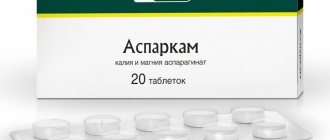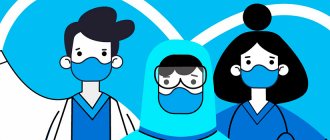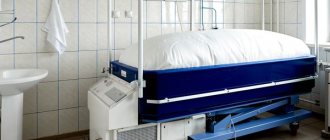Manual therapy (or manual medicine) is one of the areas of alternative medicine that deals with the treatment and diagnosis of spinal diseases.
Manual therapy of the spine
The first mentions of manual practices date back to the beginning of the 18th century: in those days, chiropractors were called chiropractors (this term is still used among the people today). Today, a chiropractor is a specialist with a higher education in the specialty “Orthopedics” or “Neurology” and a license to engage in this type of activity.
Chiropractor - doctor with higher education
Treatment by a chiropractor allows you to correct spinal pathologies in the initial stages, improve the functioning of internal organs, increase the body's resistance to pathogens and get rid of chronic headaches and migraines. Despite the fairly stable positive results of using manual methods in patients with chronic back diseases, not everyone can use this method of alternative treatment due to a large list of contraindications.
What is manual medicine?
Manual medicine is a complex of various techniques in which the doctor acts on the affected segments of the spine using his hands. If you visually evaluate the work of a chiropractor, you can say that this is an ordinary back massage, but this is absolutely not the case. During the massage, the specialist works on soft tissues (musculo-ligamentous apparatus), and his main task is to restore normal microcirculation and muscle tone. Unlike a massage therapist, a chiropractor works not only on paravertebral (paravertebral) muscles, but also on deeply located organs: bones, joints, tendons, osteochondral joints and internal organs.
The doctor acts on the affected segments of the spine using his hands
The method is based not only on a direct stimulating effect on the soft tissues surrounding the spine, but also on the bone structures that make up the central part of the human axial skeleton. With the correct implementation of various techniques, it is possible to achieve normalization of the anatomical location of the vertebrae when they are displaced and eliminate muscle spasms that occur when the muscle fiber is injured by vertebral osteophytes (bone growths).
If you want to learn in more detail what osteophytes on the spine are, and also consider the causes, symptoms and treatment methods, you can read an article about it on our portal.
What to do if you have back problems?
If symptoms of osteochondrosis appear, then at the first stage it is necessary to be examined by a qualified specialist. This is necessary to determine neurological and orthopedic disorders, order the necessary studies for correct diagnosis and determine treatment tactics. An incorrect diagnosis can sometimes lead to very serious complications!
Most patients understand perfectly well that they will be treated not by the name of the technique or the name of the medical institution, but by an ordinary practicing doctor. The real result of treatment depends on his professional qualities. Hand healing usually requires experience and care. In some cases there are contraindications that need to be recognized and properly assessed.
In connection with the above, it is important to clearly understand that only a certified doctor who has undergone special training and has the appropriate certificate has the right to carry out such treatment.
Are manual medicine and osteopathy the same thing?
Osteopathy is a branch of alternative medicine, which is based on the theory of the inextricable connection between the functioning of internal organs and bone-anatomical structures, the basis of which is the human spine. Despite the fact that chiropractors are often called osteopaths or chiropractors, both directions cannot be designated by a single term, since osteopathy in its classical sense is part of manual medicine.
Osteopathy
A certified osteopath can help solve the following problems:
- increasing the adaptability of the human body and organism to environmental conditions and its manifestations, including various injuries (the idea of self-healing);
- normalization of the hematopoietic and circulatory system;
- harmonious restoration of the nervous system;
- increasing the physiological mobility of the body.
In osteopathy, increasing physiological mobility means not only the work of joints, muscles and bones, but also the frequency and strength of respiratory movements, as well as the pulsation of blood vessels.
Types of osteopathy
Qualities a doctor should have
Not all manual technicians are excellent specialists. The master must have not only deep knowledge and understanding of his business. What is important for him are sensitive, strong hands, a penchant for this work, a good memory, a desire and the opportunity to expand his knowledge throughout his life.
It is extremely important that the doctor feels responsible and confident in his abilities. After all, the smallest wrong move can cost a person quite a lot.
A real specialist can be a neurologist or an orthopedist. After all, it is important not only to deeply understand the anatomical and physiological foundations, but also to master diagnostic and therapeutic methods. Often a specialist has to look at and evaluate radiographs, ultrasound reports, and cardiograms.
Best materials of the month
- Coronaviruses: SARS-CoV-2 (COVID-19)
- Antibiotics for the prevention and treatment of COVID-19: how effective are they?
- The most common "office" diseases
- Does vodka kill coronavirus?
- How to stay alive on our roads?
In order to become a chiropractor, you must first graduate from a medical school. You will need to undergo specialization in neurology or traumatology with a course in orthopedics. In the future, you can master manual therapy.
What diseases does a chiropractor treat?
Chiropractors treat pathologies of the musculoskeletal system, the central segment of which is the spine. The spine consists of vertebrae that are connected to each other in a vertical sequence using fibrocartilaginous formations. These formations are called intervertebral discs. They act as a shock absorber and “dampen” axial and impact loads on the spine, preventing premature deformation and abrasion of the surface of neighboring vertebrae.
The structure of the vertebrae (lumbar in the diagram)
When the functions of the intervertebral discs are disrupted, spinal deformation occurs (primarily due to a decrease in the height of the vertebral bodies and their displacement).
Where does the specialist meet?
Often, chiropractors work in diagnostic and treatment centers of both general and specialized focus. They are often accepted in private clinics and spine treatment centers. In any case, you can get an appointment with such a specialist only by prior appointment.
The only significant difference is the number of people and the pricing policy. Everyone chooses for themselves: an acceptable price within the hospital walls or a more expensive appointment by appointment, but in comfortable conditions. The entire complex of examination, testing and therapy remains unchanged. This is in no way dependent on the reception location.
You can also find a doctor using the Internet. Online consultation is indeed less reliable, but it is accessible and very convenient. This is an opportunity to ask questions, describe the clinical picture of the disease, receive specialized answers, and, if necessary, make an appointment.
What pathologies of internal organs does a chiropractor treat?
| Organ system | Possible diseases |
| Bronchitis, pneumonia, chronic obstructive pulmonary disease, respiratory failure, bronchial asthma. |
| Chronic gastritis, colitis, gastroduodenitis, irritable bowel syndrome, chronic constipation, atony of the gastrointestinal tract. |
| Cystitis, pyelonephritis, urethritis, glomerulonephritis. |
| Chronic inflammation of the uterus and appendages (salpingoophoritis). |
Note! In some cases, taking a course of manual medicine is recommended for people with metabolic disorders and obesity, as well as patients prone to neuroses and depressive disorders.
What to expect
The duration of the massage course is determined individually, usually 5–10 sessions. Each session lasts from half an hour to one and a half. Usually the first sessions are shorter, especially if the patient's muscles are very tense and it takes time to stretch them and get to the deeper layers.
“Massage is very simple,” says Dmitry Malyshev, “the patient should feel relaxation and pain reduction after several procedures. In manual therapy, the doctor must conduct the necessary preliminary examination, often radiography is sufficient, to exclude contraindications to manual therapy.”
The course of manual therapy is determined individually, after the first consultation and examination by a specialist. Each session lasts about half an hour, during the process the doctor warns if it may be unpleasant and tells what this is connected with.
Impact techniques
Despite the fact that a chiropractor treats only with the help of his hands and his own touch, there are various methods of influencing the human spine, each of which gives a specific therapeutic result.
If you want to learn in more detail about the technology of manual therapy for osteochondrosis of the cervical spine, you can read an article about it on our portal.
Manual techniques in the treatment of spinal diseases
Features of the effect on different parts of the spine
For each patient, the technique and nature of the impact are selected individually depending on the type and severity of the existing disorders. However, there are some general rules that chiropractors adhere to.
- Before the start of any active treatment, relaxation is carried out to achieve the desired level of muscle relaxation and prepare them and the skin for subsequent procedures. It is also used at the final stage of the session.
- Work with the spine begins with exposure to the thoracic region, then moves to the lumbar and only then to the cervical.
- If it is necessary to correct deformities of the cervical or lumbar spine, preference is usually given to rotational techniques. At the same time, pressure techniques are more often used to improve the condition of the thoracic spine.
- Working with the cervical spine requires a particularly highly qualified chiropractor, since it is he who is most susceptible to damage and injury of various kinds.
The duration of treatment depends on the severity of the existing disease. As a rule, in mild cases, 3-4 sessions are required to achieve noticeable results; in advanced situations, more than 15 procedures will be required.
How is the reception going?
Full treatment with a chiropractor usually begins with the second visit. At the initial appointment, the doctor will collect a detailed medical history, conduct a manual (physical) examination and palpation of the spine to identify painful and trigger points, possible displacement of the vertebrae and other deformities of bones and joints.
Starting from the second appointment, a direct therapeutic effect is carried out, which always begins with relaxation and ends with mobilization or manipulation (or a combination of both). The duration of the session is usually from 20 to 45-50 minutes, and no more than 2 sessions are prescribed per week, since the muscles need time to recover and adapt to the new position. To assess the dynamics of the therapy, it is necessary to undergo at least 3 sessions. The maximum possible result is usually achieved after 5-7 procedures.
Video – Manual therapy session
Important! For patients leading a sedentary lifestyle, with severe hypodynamic disorders and weak muscle strength, the doctor may recommend wearing a special corset or bandage for several weeks to reduce discomfort after therapy and quickly restore muscle fiber.
Scope of competence
The doctor diagnoses diseases of the musculoskeletal system and nervous structures. The required volume of therapy is determined individually. This allows you to defeat the most severe lesions and prevent their relapses.
Procedures may be prescribed during the recovery period after surgery. This can significantly alleviate the condition and eliminate pain.
Why is preliminary diagnosis necessary?
Before starting treatment, a manual medicine specialist will definitely ask the patient for the results of a magnetic resonance scan, ultrasound or radiography. This is necessary for an objective assessment of the functional state of the spine and identification of possible contraindications that the patient may not be aware of.
Before starting treatment, the patient must undergo diagnostics and provide the results to the chiropractor
For the same purpose, a blood test is carried out before sessions in order to promptly identify signs of infectious, inflammatory or tumor processes in which manual therapy is contraindicated.
Note! Patients at risk for intervertebral hernias and protrusions (these are mainly patients with chronic osteochondrosis) should have an MRI before going to a chiropractor, since X-ray examination is ineffective for this pathology.
Patients with hernias and protrusions provide the results of an MRI study
Treatment approaches
Before starting such treatment, it is imperative to diagnose the affected structures. Only after examination, clarification of complaints, X-rays, or MRI, sometimes ultrasound, can one see the presence of indications, the features of the course and the complexity of the process. This is why a true specialist will never work in isolation from a medical facility.
It is impossible to heal in one session. On the contrary, in most cases, after the first procedures, patients often feel a significant deterioration in their health, an exacerbation of the process. This is a normal reaction that goes away within a couple of days.
The main task of any doctor is to do no harm. Therefore, the specialist categorically avoids excessive, aggressive and dangerous influences. It has been proven that the maximum positive effect comes from a soft, osteopathic effect. The doctor works especially carefully with children and the elderly. Whatever the method, the patient is always fully monitored, and any changes in well-being are taken into account.
Contraindications and restrictions
Manual therapy refers to methods of active influence on the spine, so such procedures have many contraindications. These include:
- infectious diseases (including spinal infections);
- inflammatory processes in the spine and surrounding tissues in the acute stage;
- pathologies accompanied by a decrease in bone mass density (osteoporosis, bone metastases);
- cancerous formations (regardless of location);
- fresh injuries of the musculoskeletal system;
- malignant hypertension.
Use in children is not recommended until the age of 7 years.
Contraindications to manual therapy (recommendations of the Center for Manual Therapy of the Russian Ministry of Health)
Methods
In manual therapy, there are 3 methods of influence: manipulative, craniosacral and visceral. The first is used most often and is based on working with the spine.
Craniosacral manual therapy involves influencing the bones of the skull and actively working on the vertebrae of the cervical spine. Thanks to her, she manages to:
- normalize intracranial pressure;
- improve blood supply to the brain;
- get rid of migraines;
- improve the quality of cognitive functions, i.e. attention, memory, etc.
Visceral therapy consists of a gentle effect on the internal organs of the abdominal cavity and the muscular corset. Targeted, precise actions of a specialist in the abdominal area lead to increased blood circulation and improved metabolic processes.
This ensures increased trophism of tissues and organs, which has a beneficial effect on the functioning of the heart, bronchi, lungs, gastrointestinal tract, kidneys and pelvic organs. As a result, the internal organs return to their normal position and gain natural mobility. The method is widely used not only for the correction of pathological conditions, but also to eliminate the consequences of past diseases, as well as to prevent the development of complications after injuries, surgical interventions, childbirth, etc.
All methods used in manipulative manual therapy can be divided into direct and indirect, passive and active, hard and soft. Each of them involves the use of special techniques, among which the most common are:
- manipulation;
- mobilization;
- post-isometric relaxation.
Particularly pronounced results with a gentle effect on the body are achieved by using the method of Russian academician Anatoly Grigorievich Gritsenko. He managed to form his own system of manual manipulation, which, in combination with the use of other well-known techniques, raised thousands of people to their feet and relieved pain of varying intensity.
Manipulation or push mobilization
Push mobilization is a widely used technique that involves a single, not too strong, but sharp push in the direction of the most pronounced restriction of movement. This technique is carried out at the moment of exhalation and the greatest relaxation of the body, which is usually observed when the patient does not expect any active actions. Thanks to push mobilization, the boundaries of joint mobility change, which leads to a significant increase in motor capabilities.
The correctness of the technique is eloquently indicated by a characteristic click. In this case, the functional block that limits mobility in this spinal motion segment is eliminated. After realignment of the vertebrae, the muscles relax, tension and pain caused by pathological changes are eliminated.
Although at first glance it may seem that the click or crunch is heard due to the bone element jumping into the desired place, in reality this is not entirely true. Its nature is still not known exactly, but the main version of its appearance is called the vacuum phenomenon, which implies the separation of previously tightly connected surfaces.
Mobilization
This is a technique of active influence on the spine, allowing:
- eliminate joint subluxations;
- return displaced vertebrae to normal position;
- reduce osteochondral protrusions called exostoses;
- eliminate increased muscle tone, spasms;
- significantly increase motor capabilities;
- activate the body's natural recovery processes.
It includes several types of techniques. Therefore, mobilization is distinguished:
- rhythmic;
- positional.
Rhythmic mobilization
This manual therapy technique is quite painful, but very effective. It is easy to implement for a specialist and facilitates the rapid elimination of functional blocks.
The essence of rhythmic mobilization is to perform traction of the spine followed by rotation (turning) of its rhythmic oscillatory movements. That is, initially the chiropractor stretches the joints without excessive effort, which helps to increase the distance between individual vertebrae.
Then he shifts the desired vertebrae to the sides relative to each other and smoothly swings them in the direction of restricting mobility. The technique is performed rhythmically with an intensity of 1–2 movements every second.
If the use of rotational movements is impossible, for example, in the sacral area, rhythmic pressure is applied to the desired areas. This compression effect is also used in the first sessions of manual therapy, when the muscles still maintain high tone.
Positional mobilization
This method of manual therapy can be called universal. It combines elements of rhythmic mobilization, PIR and manipulation. It involves a gentle impact at a slow pace.
Initially, the chiropractor finds the position in which the greatest tension is observed in the joints, and holds the patient in it with slight force for 1-2 minutes. Additionally, the flexor muscles are stretched and the extensor muscles are contracted, which leads to the correct distribution of the load on them while maintaining an upright body position.
Postisometric relaxation
The post-isometric relaxation method or PIR is one of the soft impact techniques. It promotes:
- pain relief;
- achieving maximum relaxation and stretching of the muscles in the spine;
- increasing the elasticity of muscle fibers.
This allows you to prepare the body for active exposure or relax after it. All movements are performed carefully and gently while inhaling. In this case, the patient needs to strongly tense the muscles. After a few seconds, they will reflexively relax, at which time the chiropractor, holding the patient’s body with one hand, makes pressing movements in the desired direction with the other. Returning to the starting position is carried out while exhaling. This causes muscle stretching and complete relaxation.
The procedure is repeated 7–10 times. This is enough for the muscles to relax, become soft and allow the specialist to perform the necessary manipulations at a deeper level, including the spine.
PIR techniques can be used on any part of the spine, but differ in different techniques.
Method of A. G. Gritsenko
A. G. Gritsenko’s method has been practiced for more than 27 years, but it takes more than one year to fully master it. Therefore, unfortunately, there are still quite a few specialists who successfully practice it.
It is based on restoring the body's reserve capabilities through the spine. The human body has the ability to recover when a negative factor is eliminated, which is usually the displacement of the vertebrae relative to the normal axis of varying degrees of severity.
Against the background of various factors, among which the leading positions are occupied by a sedentary lifestyle, heavy lifting and genetic predisposition, nerve fibers are pinched by displaced vertebrae. This leads to disruption of the functions of the spinal cord, which innervates organs, endocrine glands, muscles, skin, etc. Therefore, when it or the nerve roots extending from it are pinched, the connection between the organ and the nervous system is disrupted. This leads to a decrease in their functionality, since the organ stops receiving commands, which becomes a fundamental impetus for the occurrence of pathological changes in it.
Gritsenko’s method is based specifically on normalizing the position of the vertebrae, eliminating spinal deformation, which allows the release of pinched nerves and eliminate pressure on the spinal cord. It leads to:
- normalization of the spinal cord;
- restoration of nerve conduction;
- elimination of pain syndrome.
A. G. Gritsenko’s method has 95 patents and is unique. It involves carrying out ultra-precise, targeted, one might say, jewelry-like effects on each vertebra of the spinal column, which leads to the restoration of their normal axial position and the elimination of pathological processes in the body.
Treatment using the method of A. G. Gritsenko can be combined with work of any kind and business trips. Each session lasts from 10 minutes to half an hour, which depends only on the patient’s condition. As a result, there is often no need for surgery and continued expensive drug therapy.
Is it possible to undergo treatment during pregnancy?
Despite the fact that some experts talk about the possibility of treatment during pregnancy, representatives of traditional medicine recommend abandoning manual therapy during pregnancy and breastfeeding. Women with chronic osteochondrosis and other diseases of the spine should know that incorrect manipulations on this musculoskeletal segment during pregnancy can cause miscarriage (regardless of gestational age).
It is better to replace manual therapy with massage
Features of follow-up and doctor’s recommendations
A specialist may recommend changing your physical activity and type of diet. It is also important to consider that:
- After the session, you should not get up suddenly; it is better to do it slowly.
- Within 24 hours after the procedure, you should avoid heavy lifting and avoid sports.
- After the session, hypothermia and overheating (drafts, hot bath) are unacceptable. The first can lead to spasm in areas of intense impact, the second can lead to swelling.
The doctors of our Clinic will never refuse you further consultations. They will recommend a follow-up date after treatment to assess effectiveness.
Manual therapy during menstruation
Menstruation is not a direct contraindication for manual therapy sessions, but it is better to refuse treatment until the end of your period. Manual exposure can lead not only to increased menstrual pain, but also to more abundant and prolonged discharge (menorrhagia).
Video - Manual therapy of the cervical spine
Manual therapy is a fairly effective method of treating the spine and many internal organs, such as the reproductive system or respiratory tract. When choosing a chiropractor, you need to be interested not only in reviews of a particular specialist, but also in whether he has a diploma, certificate and license. Treatment by a non-professional can cause displacement and fracture of vertebrae, rupture of ligaments, muscle injury and other serious complications, so this issue must be approached very responsibly.
According to statistics, the popularity of therapeutic massage today is increasingly growing, and it is gradually becoming almost the most popular means of alternative medicine. Any back and neck massage, regardless of technique, can bring both benefit and harm. Therefore, before doing the procedure, read the contraindications. If you have any doubts, it is better to consult a specialist. And detailed information about massage techniques, contraindications and benefits of procedures can be obtained on our website.
When you need help from a manual technician
Experts themselves claim that such procedures are always needed by everyone. Often, even an infant requires sessions to restore the correct position of the vertebrae in some part. A person develops problems with his or her motor system. Most of them are connected to the spine. That is why patients of any age, gender and social status turn to the doctor.
The main task of a specialist is to establish biomechanics and normalize activity:
- spine;
- muscle elements;
- bone structures;
- ligaments
After all, the functioning of the brain, heart and other organ structures depends on this. Such patients also have problems with endocrine, respiratory, and digestive structures. Innervation, lymph flow and blood supply are significantly impaired.
The doctor is able to determine the root cause, show the patient weak points, and point out lifestyle features that prevent exacerbation or progression of the disease.
Alas, the possibilities of the doctor, as well as the therapy itself, are not limitless. Sometimes a patient can be cured only by surgery. This technique for treating the spine is performed exclusively by a neurosurgeon.
Briefly about osteochondrosis.
Many patients answer the question: “What’s bothering you?” they answer briefly: “I have osteochondrosis,” while treating their diagnosis as something ordinary and not serious: it’s the same for everyone. In fact, osteochondrosis is not just a change in bones and cartilage (as it is translated into Russian), it hides a whole set of syndromes, the so-called neurological manifestations of spinal osteochondrosis. And each person may have his own syndrome or even a complex of syndromes. The most common are muscular-tonic syndromes: stiffness in the neck, lower back, between the shoulder blades, in the shoulder girdle, in the buttocks, in the muscles of the thigh and shoulder, in the muscles surrounding the shoulder and hip joints. In addition, manifestations of osteochondrosis are vertebral artery syndrome, radiculopathy of various nerve roots, when the patient is bothered by lumbago and prolonged pain in the form of a stripe (previously it was called radiculitis), headache syndrome (cleverly sounds: cranialgia of vertebral origin), intercostal neuralgia, reflex cardialgia (heart Cardiologists have tested it inside and out: both during exercise and at rest, and with daily monitoring - the heart is healthy, but it still hurts, especially with nervous tension), functional blocks of the vertebrae (in this case, for example, there is a limitation in turning the head to the left or right, body in the lower back to the left or right, or there is an involuntary desire to bend your back back, “so that something clicks there,” or, conversely, bend forward and stretch the longitudinal muscles of the back). Osteochondrosis also includes intervertebral hernia (destruction of intervertebral discs). The elimination of these syndromes is what manual therapy does, except in the situation where the vertebrae are fused and an attempt to separate them will lead to a fracture of the vertebrae.









